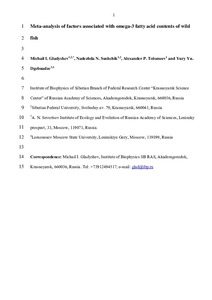Показать сокращенную информацию
Meta-analysis of factors associated with omega-3 fatty acid contents of wild fish
| Автор | Гладышев, Михаил Иванович | |
| Автор | Сущик, Надежда Николаевна | |
| Автор | Толомеев, Александр Павлович | |
| Автор | Дгебуадзе, Юрий Юлианович | |
| Дата внесения | 2019-07-01T07:29:20Z | |
| Дата, когда ресурс стал доступен | 2019-07-01T07:29:20Z | |
| Дата публикации | 2018-04 | |
| Библиографическое описание | Гладышев, Михаил Иванович. Meta-analysis of factors associated with omega-3 fatty acid contents of wild fish [Текст] / Михаил Иванович Гладышев, Надежда Николаевна Сущик, Александр Павлович Толомеев, Юрий Юлианович Дгебуадзе // Reviews in Fish Biology and Fisheries. — 2018. — Т. 28. — С. 277-299 | |
| ISSN | 09603166 | |
| URI (для ссылок/цитирований) | https://link.springer.com/article/10.1007/s11160-017-9511-0 | |
| URI (для ссылок/цитирований) | https://elib.sfu-kras.ru/handle/2311/111341 | |
| Аннотация | Fish are recognized as the main source of physiologically important omega-3 long-chain polyunsaturated fatty acids, namely, eicosapentaenoic acid (EPA) and docosahexaenoic acid (DHA), for human nutrition. However, muscle tissue contents of these fatty acids in diverse fish species, i.e., their nutritive value for humans, varied within two orders of magnitude. We reviewed contents of EPA and DHA, measured by similar methods using an internal standard during chromatography as mg per g of wet mass in 172 fish species belonging to 16 orders, to evaluate probable variations in phylogenetic and ecological drivers. EPA ? DHA content varied from 25.6 mg g-1 of wet mass (Sardinops sagax) to 0.12 mg g-1 (Gymnura spp.). Multidimensional redundancy analysis revealed that among phylogenetic, ecomorphological and abiotic environmental factors, the highest proportion of variation contribution belonged to the shared contribution of sets of phylogenetic and ecomorphological factors. Specifically, the highest values of EPA ? DHA content were characteristic of fish belonging to the orders Clupeiformes or Salmoniformes, were pelagic fast swimmers, ate zooplankton and inhabited marine waters or migrated from fresh to marine waters (anadromous migrations). High EPA and DHA content in muscle tissues of the above species appeared to be a metabolic adaptation for fast continuous swimming. In contrast to common beliefs, our meta-analysis did not support the significant influence of higher trophic levels (piscivory) and cold environments (homeoviscous adaptation) on EPA and DHA content in fish. However, many causes of high and low levels of physiologically important fatty acids in certain fish species remained unexplained and require evaluation in future studies. | |
| Тема | Docosahexaenoic acid | |
| Тема | Ecomorphological factors | |
| Тема | Eicosapentaenoic acid | |
| Тема | Nutritive value | |
| Тема | Phylogenetic factors | |
| Название | Meta-analysis of factors associated with omega-3 fatty acid contents of wild fish | |
| Тип | Journal Article | |
| Тип | Journal Article Preprint | |
| Страницы | 277-299 | |
| ГРНТИ | 34.35.33 | |
| Дата обновления | 2019-07-01T07:29:20Z | |
| DOI | 10.1007/s11160-017-9511-0 | |
| Институт | Институт фундаментальной биологии и биотехнологии | |
| Подразделение | Кафедра водных и наземных экосистем | |
| Журнал | Reviews in Fish Biology and Fisheries | |
| Квартиль журнала в Scopus | Q1 | |
| Квартиль журнала в Web of Science | Q1 |

